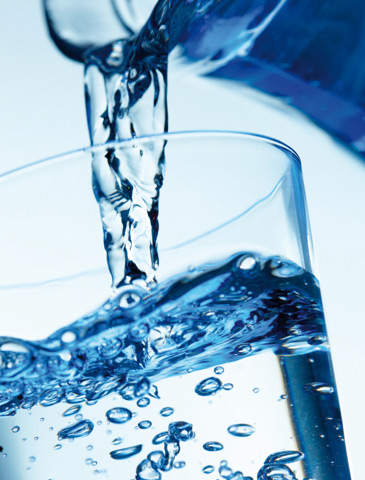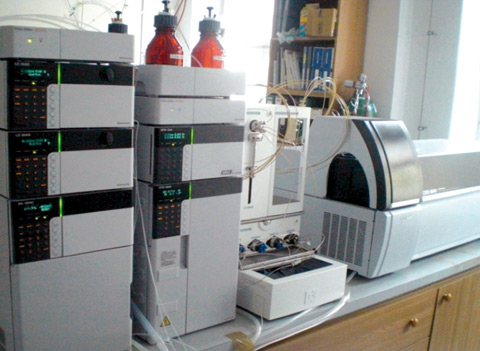Feed to Food
Strategies for measurement of pesticides in water and foods

Water is not only the basis for all life, but it is also an important resource for many types of production processes, particularly in agriculture. Fresh water sources especially in surface and ground water are of vital importance to humans, but they occur in low amounts only. Water plays a role in various applications, for instance as a foodstuff in the form of drinking water or as a basis for food and beverage preparation. Water is also important in the production or supply of raw materials in industry and agriculture [1,2].
This is why water plays a central role in the food chain and why contaminations have a direct effect on human health. Plant protection products (PPPs) are used extensively and comprehensively in agriculture to increase production. As a result, PPP residues can persist on foods and feedstuff or leach into surface and ground water via various routes. In addition, PPPs are prone to conversion and degradation processes which may lead to the formation of many different metabolites over time. In monitoring programs these metabolites, with their often widely varying physicochemical properties, must also be taken into account, resulting in highly complex requirements on analysis strategies.
Method: Analysis of plant protection products
In food analysis, the QuEChERS (quick, easy, cheap, rugged and safe) method as described by Anastassiades et al. has become increasingly popular in recent years [3]. In this method, the sample is extracted with acetonitrile, the extract is subsequently mixed with buffer salts and purified by the addition of suitable additives (PSA, C18, GCB). The extract can then be measured directly using GC-MS or LC-MS.
In recent years, much work has been carried out to validate this method for many different food matrices [4 – 11]. The development of multi-analyte methods in the fields of GC-MS and LC-MS technology has advanced considerably whereby it is now possible to simultaneously determine more than 100 analytes within a single analytical run. If a limit of determination of 10 µg/kg has to be achieved, a system determination limit of 10 µg/L is usually sufficient for these methods and is, in general, easily achievable using state-of-the-art instrumentation.
The situation is different in residue analysis of water intended for human consumption in accordance with EU Council Directive 98/83/EC [12], where a single substance must be quantified with a limit of determination of 0.1 µg/L. For pesticides in particular, which must be determined using LC-MS in the ESI (electrospray ionization) negative mode, this limit of determination often cannot be achieved without additional sample preparation, such as an enrichment step.
It is also known that the ESI ionization source is highly sensitive to matrix effects [13]. Especially, fluctuating salt concentrations and organic compounds such as humic substances very often lead to ionization suppression but also to ionization amplification [14]. This can subsequently lead to false-low or false-high measurement results in pesticide analysis. The required sample enrichment step and, in particular, the removal of undesirable matrix components, often necessitates unavoidable sample preparation methods such as solid-phase extraction (SPE) in water analysis. Such steps usually require expenditures in time, personnel and resources.
One possibility to achieve complete automation with minimal sample and solvent amounts is the use of online SPE-LC/MS systems. Water samples of just a few milliliters can be simultaneously enriched, purified and measured using multi-analyte methods. HPLC buffers are simultaneously used for sample extraction as well as for analysis. The total analysis times for sample preparation and measurement can thus be reduced to just a few minutes, as demonstrated by ESW Consulting Wruss, a company in the field of environmental analytics, using Shimadzu’s LCMS-8040 [15].
 Online-SPE-HPLC-ESI-MS/MS
Online-SPE-HPLC-ESI-MS/MS
Conclusion: Automated online analysis of water samples
Particularly in view of the large number of PPPs (> 1,000) used worldwide, analytical systems must be very flexible and easily applicable with regard to the substances to be analyzed. Sample throughput and analysis time play an essential role in routine laboratories. Economical use of materials and solvents and the required sample amounts are of great importance in the context of extensive monitoring programs.
By using such automated online systems, errors in the sample preparation process can be reduced to a minimum and analysis becomes more robust with respect to a wide range of matrices in the extraction of water samples of different origins.
Author
Oliver Mann, Wruss Umweltanalytik
Literature
[1] R. Mull, H. Nordmeyer, Pflanzenschutzmittel Im Grundwasser – Eine Interdisziplinäre Studie, Springer-Verlag, 1994.
[2] A. Reller, L. Marschall, S. Meißner, C. Schmidt, Ressourcenstrategien, WBG, 2013.
[3] M. Anastassiades, S.J. Lehotay, D. Stajnbaher, F.J. Schenck, J. AOAC Int. 86 (2003) 412.
[4] S.W. Lee, J.-H. Choi, S.-K. Cho, H.-A. Yu, a M. Abd El-Aty, J.-H. Shim, J. Chromatogr. A 1218 (2011) 4366.
[5] D. Tomasini, M.R.F. Sampaio, S.S. Caldas, J.G. Buffon, F.A. Duarte, E.G. Primel, Talanta 99 (2012) 380.
[6] R.P. Carneiro, F.A.S. Oliveira, F.D. Madureira, G. Silva, W.R. De Souza, R. Pereira, Food Control 33 (2013) 413.
[7] M.R.F. Sampaio, D. Tomasini, L.V. Cardoso, S.S. Caldas, F.A. Duarte, E.G. Primel, Anal. Methods (2013) 2028.
[8] U. Koesukwiwat, K. Sanguankaew, N. Leepipatpiboon, Anal. Chim. Acta 626 (2008) 10.
[9] S.C. Cunha, J.O. Fernandes, a Alves, M.B.P.P. Oliveira, J. Chromatogr. A 1216 (2009) 119.
[10] S.J. Lehotay, A. de Kok, M. Hiemstra, P. Van Bodegraven, J. AOAC Int. 88 (2005) 595.
[11] S. Walorczyk, J. Chromatogr. A 1208 (2008) 202.
[12] The Council of the European Union, Off. J. Eur. Communities (1998) 32.
[13] C.R. Mallet, Z. Lu, J.R. Mazzeo, Rapid Commun. Mass Spectrom. 18 (2004) 49.
[14] A.C. Hogenboom, M.P. Hofman, D.A. Jolly, W.M.A. Niessen, U.A.T. Brinkman, J. Chromatogr. A 885 (2000) 377.
[15] O. Mann, E. Pock, K. Wruss, W. Wruss, R. Krska, Int. J. Environ. Anal. Chem. (2016).